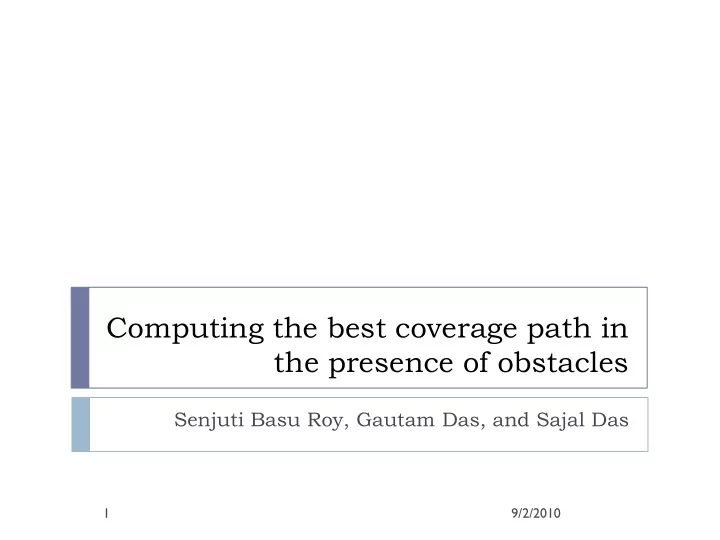

Computing the best coverage path in the presence of obstacles Senjuti Basu Roy, Gautam Das, and Sajal Das 1 9/2/2010
Outline Problem formulation 1. Problem for opaque obstacles 2. Problem for transparent obstacles 3. Conclusion 4. 2 9/2/2010
Problem formulation The cover value of a path from s to t is the maximum distance from a point of the path the its closest sensor. Best coverage path from s to t, BCP(s, t), is the path that has minimum cover value. Model: Set S of n sensors and set O of m line segment obstacles. T wo types of obstacles: Opaque obstacles: obstruct paths and the line of sight of sensors Transparent obstacles: obstruct paths but allow sensors to see through them. 3 9/2/2010
Problem for opaque obstacles Constrained weighted Voronoi diagram is a set of Voronoi cells such that and for all Observation: Each path go through a set of cells and intersects with them at the cell boundaries. The problem is solved if we can find the set of these intersections. 4 9/2/2010
Problem for opaque obstacles There are three types of edges of CW-Voronoi Diagram: (1) A part of obstacles (2) A part of a perpendicular bisector between two sensors (3) A part of an extension of a visible line Set of possible intersections: Type 1, 2, 3: two ends of the edge. Type 2: The intersection of the line formed by two sensors and the edge. 5 9/2/2010
Dual graph of CW-Voronoi diagram Vertex set: set of sensors, the vertices of Voronoi diagram, s, t. Edge set: For each edge (u, v) of Voronoi diagram that separate cells labeled by S 1 and S 2 , add four dual edges (u, S 1 ), (u, S 2 ), (v, S 1 ), and (v, S 2 ). If (u, v) intersect with S 1 S 2 at T, add edges (S 1 , T), (S 2 T). For each edge (u, v) of type 1, which belongs to the cell labeled by sensor S, add two edges (u, S) and (v, S). The weight is the Euclidian between two ends points. 6 9/2/2010
Algorithm to compute BCP(s, t) Time complexity: (1) takes time and space to construct a CW-Voronoi diagram with number of edges and vertices. Bellman-Ford algorithm at step 3 takes time . .The total time is . 7 9/2/2010
Problem for transparent obstacles Visibility graph o n locations is the graph of n vertices where there is an edge between a pair of vertices if they see each other. Observation: At least a BCP is contained in visibility graph 8 9/2/2010
Problem for transparent obstacles A BCP which does not follow the visibility edges makes some bend either: Type 1: Inside a Voronoi cell Type 2: At a Voronoi bisector Type 3: At a Voronoi vertex Eliminate bends by replacing a arbitrary path from A to B by a line segment from A to B. 9 9/2/2010
Problem for transparent obstacles Weight of visibility edge Decompose an edge into separate line segments, each segment belong to a Voronoi cell. Weight of each segment is Euclidian distance from the farther end to the corresponding sensor. Weight of the edge is the max weight over all segments. 10 9/2/2010
Algorithm computes BCP(s, t) Time complexity: Step 1 takes to construct visibility graph where x is the number of visibility edges. Assigning weight to each edge takes O(n) time. Then step 3 takes . Step 4 finishes in . T otal time is . 11 9/2/2010
Conclusion The algorithms requires to know exactly locations of all sensors, obstacles. Centralized algorithms. Does not solve the Maximum breach path problem. 12 9/2/2010
Recommend
More recommend